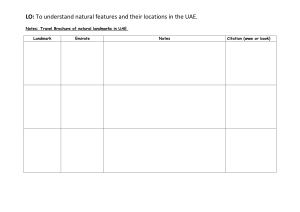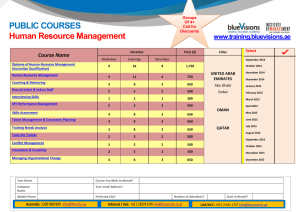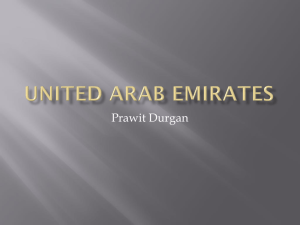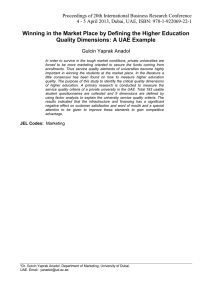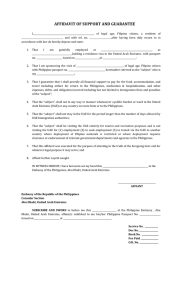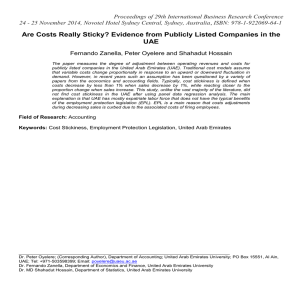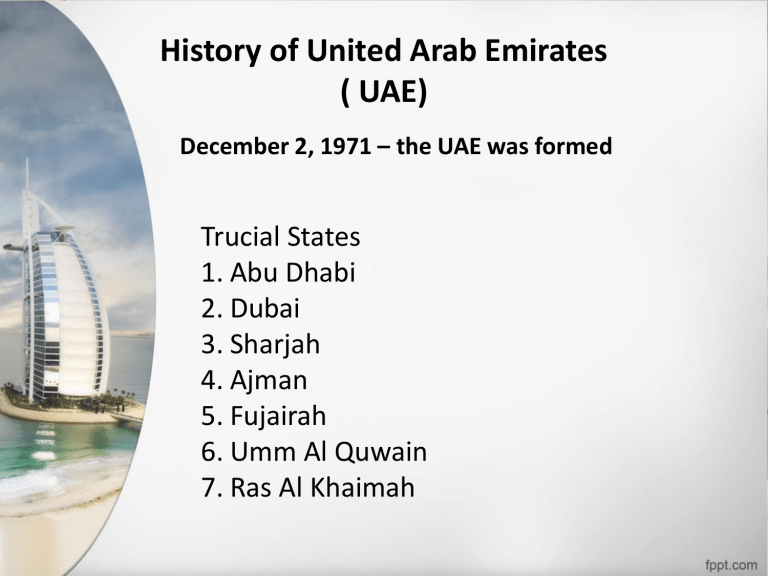
History of United Arab Emirates ( UAE) December 2, 1971 – the UAE was formed Trucial States 1. Abu Dhabi 2. Dubai 3. Sharjah 4. Ajman 5. Fujairah 6. Umm Al Quwain 7. Ras Al Khaimah Influences: European - The British ties were made with the Trucial States which promises to protect the coast from all the aggression by sea and to provide assistance during any land attacks. By 1960s, Britain imperial reach was bankrupt, and politically exhausted. In early 1968, the British declared their intention to withdraw from the Gulf, by the end of 1971. FRESH BEGINNINGS: Pearling Industry became the main economy of coastal people. It became quite profitable by 1907 created a period of wealth for UAE but began deteriorated when Japanese pearl produced in commercial quantities in the late 1920s which result to the fall of pearling industry. In 1960s oil was discovered in Abu Dhabi the capital city of UAE which now account for 30% of total UAE Gross Domestic Product. Since the discovery of oil and gas the country has become the the modern state with a high standard of living. THE FOUNDATION OF UNITED ARAB EMIRATES Seven states were formed to form union to ensure that the country would be recognized as an independent sovereign state that was part of the Arab world. Abu Dhabi was approved to be the provincial capital. Sheikh Zayed, Abu Dhabi’s ruler was elected as the first President, while Sheikh Rashid, Dubai’s ruler was elected as the Vice President. Geography, nature, climate and topography State Boarders: The UAE is a small country located in the eastern part of the Arab world, on a mostly desert stretch of land surrounded by the Persian Gulf and the Arabian Sea. The country shares borders with Oman and Saudi Arabia. With a total surface area of 83,600 square kilometer Temperature and Rainfall: In January and February the average minimum temperature ranges between 10 °C and 14 °C. From December to March, it is mostly warm and sunny. The UAE is largely an arid land with vast sand deserts, but is also characterised by sand dunes, oases, rock mountains, valleys, marshes and mangroves and salt plains. The oases are mostly of date palms; most oases are located in the emirate of Abu Dhabi Behavior and attitude of people Division of Labor and Gender Schools and Universities are segregated. Women’s participation in the labor force remains one of the lowest in the world. In spite of employment opportunities, most women opt for marriage and raising children Women do not play a significant role in politics and religious life as these areas are considered male domains Emiratis are discouraged to marry non nationals a young man receives $19,000 from Marriage Fund if he marries a national The School system has undertaken a greater role in children’s socialization, significantly reducing the family’s role in this process Markets, Trade and Environmental Issues UAE has been the top export market in the Middle East Africa region for 11 years and is a regional hub for over 1,500 American companies The UAE was on a positive trajectory before COVID-19pandemic driving down of oil prices reducing income from aviation, tourism and trade GDP fall by 4.5% in 2020 With a picking growth rate of 1.4% in 2021 Dubai World Expo 2020 is aiming to create approximately 277,000 job opportunities but postponed and scheduled on October 1, 2021 to March 31, 2022. This will boost the economy which is expected to bring $33.4 billion. UAE’s economy after 2020 will be proven to be technology- based rather than oil-based along with the entire country Environmental Threats and Issues 1.Invasive Species 2. Carbon Footprints 3. Limited water resources 4. Overfishing 5. Waste Generation 6. Land degradation and desertification Economy The UAE is run by a federal government and local governments of the seven emirates. Their powers and roles are defined by the Constitution. Under the UAE system of government, the President of the Federation is elected by a body known as the Supreme Council of Rulers. ... The Prime Minister is appointed by the President. UAE official currency is Emirati Dirham (AED) The Economy of the United Arab Emirates is the third largest in the Middle East, with a gross domestic product of US$421 billion in 2020 VAT of 5% has been implemented in UAE January 1, 2018 The rising of Burj Khalifa helps to boost the Economy Cost to build $1.5Billion Rise January 4, 2010, and built January 4, 2004 160 storey. 2,717 ft,had made $1.43Billion net profit in 2016 the firm had made $1.8 billion in profit and close to $5 billion in sales in 2017. • GDP rank -34th ( Nominal) • GDP Growth – 1.7% ( 2018), 1.7% ( 2019),-4.5 (2020) 1.4 (2021 f) • GDP by Sector - Agriculture .9%, Industry 49.8%, Services 49.2% • Labor Force - 78.3 % employment rate • Main Industries- Petroleum, petrochemicals, fishing, aluminum, cement, fertilizer, ship repair, construction, materials, handicrafts, textiles. • Gross External Debt – $237.6 billion • Public Debt – 19.7% of GDP Resources • Although the Emirates has one of the most diversified economies in the GCC, its economy is highly dependent on petroleum and natural gas which are its two primary natural resources. Over 90% of these natural resources come from Abu Dhabi. Approximately 85% of the economy of the UAE is based on oil export. Major Natural Resources • Petroleum ( Oil) • Natural gas • Solar Energy Population • The United Arab Emirates 2020 population is estimated at 9,890,402 people at mid year according to UN data. the United Arab Emirates population is equivalent to 0.13% of the total world population. the U.A.E. ranks number 93 in the list of countries (and dependencies) by population. Population by Gender UAE Population Statistics by Year (Historical population) Year Population 2020 9.89 million 2019 9.77 million 2018 9.54 million 2017 9.40 million 2016 9.27 million 2015 9.15 million 2014 9.07 million 2013 9 million 2012 8.90 million 2011 8.67 million 2010 8.27 million Population Ethnic make up Social Reponsibility and Environmental Management • Raising awareness on CSR values • Launching public-private sustainable development partnership • Strengthening the common understanding of social responsibility practice concept • Stimulating companies to implement the functioning system of social responsibility • Organizing and directing contribution of companies in community development projects Communication ( links/ Infrastracture) The telecommunication sector is contributing around 5% to the GDP of the UAE. It has been increasing over the past years, it was at 4.1% 3 years ago and now it is 5.3%. Infrastructures: Road -The UAE’s extensive road network connects each of the seven emirates and links major transportation hubs and population centers facilitation trades. Aviation – forms 28% of the GDP and contributes 22$bn annually . Important for employment. It accounts 19% of employment rate Ports - for maritime activity and transportation , UAE has numerous port facilities catering general cargo, container shipping and oil and gas industry Railways - There is Etihad railway project that is bringing the transport to entire country. Dubai metro. Telecommunication The UAE has a fast, efficient telecommunications network. The Telecommunications Regulatory Authority (TRA) is responsible for the management of every aspect of the telecommunications and information technologies in the UAE. Two telco player: 1. Etisalat ( Emirates telecommunication Corporation 2. Du- Emirate Integrated Telecommunication Company Internet penetration 99.15%
